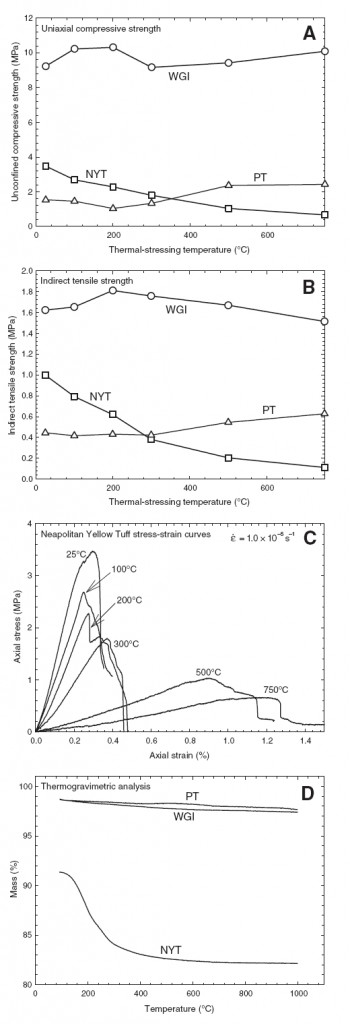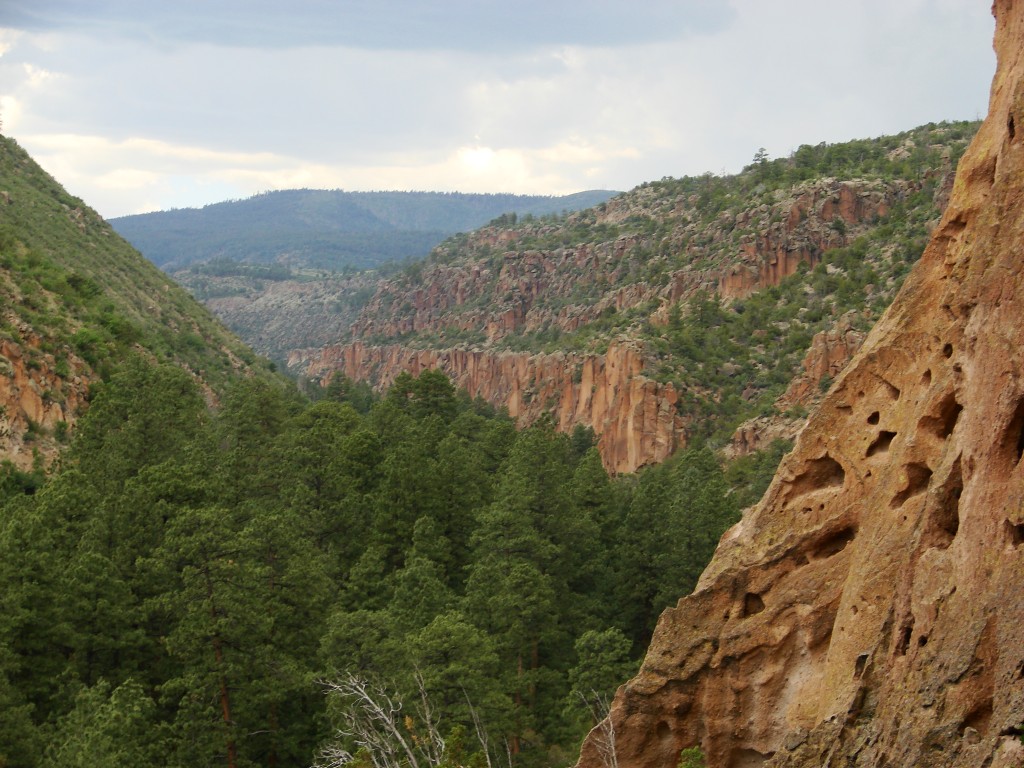25 April 2012
Hot s(tuff)
Posted by Jessica Ball
As many of you may have read last summer, I had a few issues with natural hazards unrelated to volcanology. Namely, this:
Because of the awful drought conditions in the western US at the moment, my upcoming trip to New Mexico in May isn’t looking much better in terms of my chances of avoiding close encounters of the toasty kind. I’ll be slightly more mobile in terms of stuff I need to move, but slightly less in the sense that I won’t have a car this time. So when Chuck Magee from Lounge of the Lab Lemming pointed out this article and suggested that I could take shelter in cave dwellings if there was a fire, I didn’t laugh all that hard.

Figure 3 from Heap et al. 2012, showing the results of compressive and tensile strength tests (A and B), stress-strain curves for the Neapolitan Yellow Tuff, and the results of a test to show the mass loss of each sample with increasing temperature.
Volcanic tuff isn’t a particularly strong rock, but it easy to carve and shape, which is why it’s a very popular building material. Naples, Italy is especially known for this; the Neapolitan Yellow Tuff, Campanian Ignimbrite and Piperno Tuff, all formed by eruptions of the Campi Flegrei caldera, are three of the units quarried the most often for dimension stone. In “How tough is tuff in the event of fire?”, M. J. Heap et al. take a look at a potential threat to structures built from tuff.
Volcanic hazards of living near a caldera aside, there are also secondary hazards from living in a volcanically and seismically active area, especially fire. Fires destroyed large parts of cities following the Great Kanto earthquake in Japan in 1923 and the 1906 San Francisco earthquake. The authors of this Geology paper were curious to see how the tuffs used as building materials would hold up in a fire. (Don Dingwell is especially known for testing the strength of volcanic rocks in scenarios approximating volcanic activity, so it’s not surprising that this came out of his research group!) In their experiments, they conducted uniaxial compressive and indirect tensile strength tests on thermally stressed samples of the tuffs; this basically means that they smashed the samples in various different ways until they cracked, and then recorded how heating and cooling (thermal stressing, conducted before the test) affected the rock’s breaking point.
What were the results? The authors discovered that subjecting the samples to high temperatures before the test had little effect on the strength of the rock – except in one case. The Neapolitan Yellow Tuff saw strength reductions of 80-90% in both tests (parts A and B of the figure at left), meaning it cracked a lot sooner than the other two tuffs. But why? Well, it turns out that the Neapolitan Yellow Tuff contains more zeolites than the other two tuffs. Zeolites are microporous aluminosilicate minerals which have the ability to store lots of water – in fact, they’re often used as a drying substance, or desiccant, in laboratories.
But when you dry out a zeolite, it contracts (just as a zeolite that’s taking in water will expand). If there are lots of zeolite minerals in the matrix of a rock like a tuff, this can be a severe detriment to the overall strength of the rock – according to this article, the whole rock can even expand and contract. Obviously this is not something you want your building material to do. The Neapolitan Yellow Tuff, it turns out, can lose up to 18% of its mass from those zeolites when it’s heated (part D of the figure). It also turns out that the Neapolitan Yellow Tuff is the most popular of the three building stones. The authors cite an example of the Church of Santa Chiara in Naples, which was hit by a WWII air raid in 1943; the church was constructed from the NYT and was almost completely destroyed in the resulting fire.
The authors of this study conclude with a well-supported admonition that buildings using the NYT should take additional fire mitigation precautions, due to the potential structural instabilities that could result from exposure to the high temperatures of a fire. This is a useful factor to consider not just in Naples, but in any place that uses tuff as a building material.
Because Chuck mentioned this article in reference to my upcoming trip to New Mexico, it got me wondering if retreating to a cave dwelling in the tuffs around Los Alamos would be an effective way to escape a forest fire (presumably one would resort to evacuating in a car first). The most widespread tuff in the area is the Bandelier Tuff, which is actually made up of two main members (the Tshirege and Otowi). I managed to dig up an article on the petrology and mineralogy of both, and guess what? Not many zeolites! Hooray! This means that I can take up residence in the cliff dwellings at Bandelier National Monument, assuming that Frijoles Canyon doesn’t start burning again and the flash floods aren’t an issue. At the very least I’ll have to make a trip down there to check out the fire damage, because I’m pretty sure it doesn’t look this nice anymore:
Heap, M., Lavallee, Y., Laumann, A., Hess, K., Meredith, P., & Dingwell, D. (2012). How tough is tuff in the event of fire? Geology, 40 (4), 311-314 DOI: 10.1130/G32940.1
Broxton, D. E., Heiken, G.H., Chipera, S.J., and Byers, F.M., Jr., 1995, Stratigraphy, petrography, and mineralogy of Bandelier Tuff and Cerro Toledo deposit: Los Alamos National Laboratory, LA-12934-MS, p. 33-64. http://library.lanl.gov/cgi-bin/getfile?00326203.pdf#page=38
Kranz, R. L., D. L. Bish, and J. D. Blacic (1989), Hydration and dehydration of Zeolitic Tuff from Yucca Mountain, Nevada,Geophys. Res. Lett., 16(10), 1113–1116, doi:10.1029/GL016i010p01113.




 Jessica Ball is a volcanologist at the U.S. Geological Survey, researching volcanic hydrothermal systems and stability, and doing science communication for the California Volcano Observatory. She previously worked at the Geological Society of America's Washington DC Policy Office, learning about the intersection of Earth science and legislative affairs. Her Mendenhall postdoc and PhD focused on how water affects the stability of volcanoes, and involved both field investigations and numerical modeling applications. Her blogging covers a range of topics, from her experiences in academic geosciences to science outreach and communication to her field and lab work in volcanology.
Jessica Ball is a volcanologist at the U.S. Geological Survey, researching volcanic hydrothermal systems and stability, and doing science communication for the California Volcano Observatory. She previously worked at the Geological Society of America's Washington DC Policy Office, learning about the intersection of Earth science and legislative affairs. Her Mendenhall postdoc and PhD focused on how water affects the stability of volcanoes, and involved both field investigations and numerical modeling applications. Her blogging covers a range of topics, from her experiences in academic geosciences to science outreach and communication to her field and lab work in volcanology.
I’ll be taking a look at Bandelier on June 19-20 with about 25 students in tow. It’s a fascinating place! I’m kind of sad to hear about the fires, though.
“Because of the awful drought conditions in the western US at the moment, my upcoming trip to New Mexico in May isn’t looking much better in terms of my chances of avoiding close encounters of the toasty kind.”
LOL! Chuck recommended that you stay in a cave in case of a forest fire but have you thought about ventilation? Not that I think one would happen while you’re there but just saying…
It couldn’t be any worse than the apartment I stayed in last summer – no fans or AC, just a window, plus 90-degree heat and smoke. Apparently people building in Los Alamos in the 50s didn’t understand the ventilation concept either…
I think the problem with caves and fires is that fires consume oxygen. Fire at the cave mouth will make the rest of the cave anoxic if it’s not well ventilated.
Hmm…important point. I suppose I’ll just have to make sure it’s a well-ventilated cave!
Interesting article…